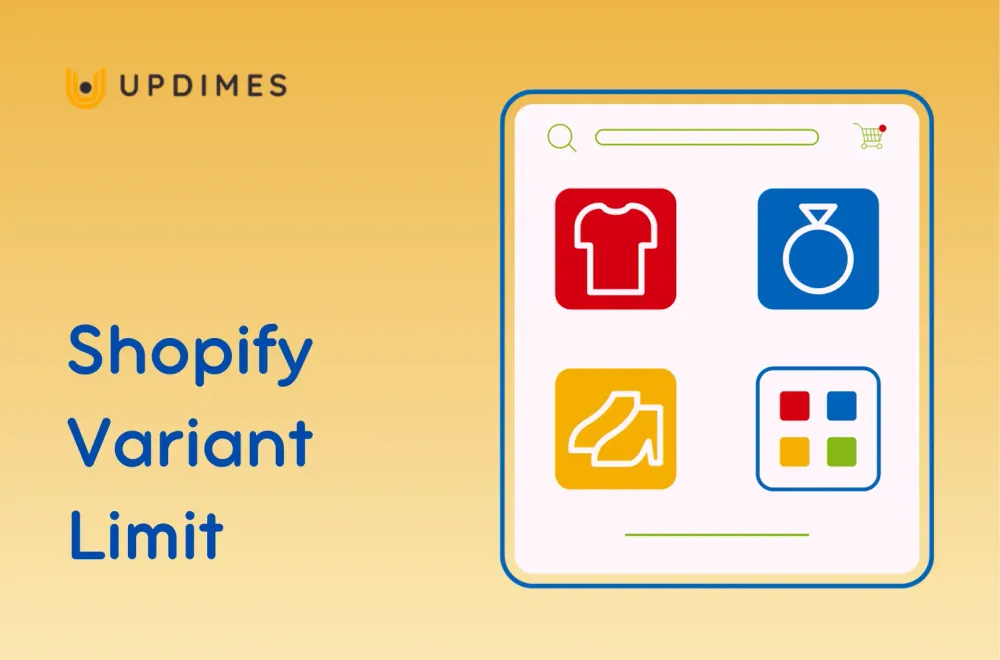Shopify Variant Limit: All You Need to Know

The Shopify variant limit is one of the most significant obstacles that Shopify merchants deal with. The variation limit can make demonstrating real product potential hard. It can be especially difficult if you run a store with a large catalog or products with several customization possibilities.
Fortunately, store owners can find workarounds. Let's go over what the Shopify variant limit is, how many you may have, and how to get around it.
What are Shopify Product Variants?
Before we get into the Shopify variant limit, let's define what a Shopify variant is.
Most online products are available in a variety of colors, sizes, materials, and pricing ranges. These purchasing alternatives are known as product variants.
Shopify product variants provide buyers with various purchasing options for a product. You can add a maximum of 100 variants (for example, different colors) and three customized options (for example, color, size, and material) per product on Shopify. Customers select the variant they require from the selections that you provide.
You can adjust the pricing of your product to match each variant when you make a new variant for it. You can also make modifications to your inventory and shipping options.
Based on the product, the options could vary. For instance, one product may allow purchasers to select sizes, colors, and materials, whereas another product in your store may provide flavor or style alternatives.
On Shopify, each variant has its own stock-keeping unit (SKU), which allows you (and any other third-party warehouses or shipping suppliers) to accurately identify every distinct item in the catalog.
What is a Variant Limit?
The variant limits the range of product variations. A product cannot have more than 100 versions on Shopify.
You may believe that 100 versions are more than sufficient for a product. But they add up quickly; one variety is a shirt in a size big and the color pink, while another is a polo in size small and pink.
As you understand, the Shopify variant limit can be a significant issue, especially if your products are available in a wide range of versions. You don't want to be compelled to limit your product offerings and offer only limited customization possibilities.
The spice of life is variety. As mass-produced goods become more common, consumers value mass customization more.
Why is There a Variant Limit?
The Shopify variant limit is a major issue for many Shopify merchants. It's a strict limit that may restrict growth. So, despite user requests, why has Shopify not fixed this?
The variant limit is incorporated into the Shopify platform. When Shopify was originally created, the variant limit was sufficient. Even now, it is sufficient for the vast majority of Shopify sellers. To replace it, however, the platform would need to undergo a radical shift or total revamp, which is simply not an option.
The variant limit is unchangeable and will remain in effect for the duration of the platform's operation. For Shopify merchants, the only way to get around this constraint is to work around it.
How to Add More Than 100 Variants on Shopify?
If a business has an e-commerce platform on Shopify, it means that they will have to give a very dynamic store in order to meet the needs of their customers. They should ensure that their items are available in such versions for consumers to purchase their preferred products. This involves connecting the variants that your store sells with your Shopify e-commerce store.
Variants might be added at different times. You can add them when creating a new product, while editing an existing product, by duplicating an existing variant, or by adding them in bulk.
Below, we'll go over the different ways you can get through Shopify's variant limit.
Method #1: Divide products into multiple pages
The simplest and most common way to work around the Shopify variant limit is to create many product listings for one product rather than placing it all under one.
Instead of offering a t-shirt with 10 colors, 5 size variations, and 3 cut options, you could build 10 product pages, each split by color. Then, for each color t-shirt, there will be 5 size possibilities and 3 cut variants, which will count toward the variant limit.
It will look amazing and add to the size of your catalog. It's also more user-friendly because buyers who struggle with product selections, particularly older generations, may overlook the customization possibilities available under a product.
Products within the same range will not have to be totally segregated. You may link the range of products even if it is divided using internal links. When a consumer is wearing one t-shirt, they may see and go to the other shirt options.
This method is most suitable for small to medium-sized businesses. If your store already has a few thousand products in its catalog, separating it even more may not be the most effective option.
Method #2: Merge by coding
The second alternative is to create your Shopify theme and combine products with variants, even if they exceed the variant limit. So, if you have two products with variant limits that have already reached the 100-variant limit, they will merge and have 200 variants on your site.
There are internet tutorials that teach how to merge items with coding, which shouldn't be too difficult if you already have some fundamental understanding. However, if you lack coding skills or Shopify website editing experience, it is best to seek out a professional.
If you decide to conduct your own coding, keep a backup of your Shopify store before altering it with the backend.
Aside from the difficulty of coding, the main disadvantage of this strategy is that it might have a negative impact on SEO. This is due to the fact that SEO integrations necessitate technical skills, such as updating meta tags.
We know that all sounds horrible. However, if your organization has the resources to engage professionals to construct this alternative, it would be a huge success.
Method #3: Use an app
Using a Shopify app is the simplest approach to get over the variation limit. Shopify's app store contains a selection of apps that enable businesses to exceed the 100 variant limit without requiring any technical knowledge.
Another advantage is that many of these applications are free or have a minimal monthly subscription. In addition to being allowed to add more variants than the Shopify variant limit, several will allow you to add more choices and modify how your choices and variants appear.
1. Infinite Options ($9.99 per month)
So, starting with the first option, we have Infinite Options.
With checkboxes, dates, and dropdown menus, Infinite Options enables you to offer customized products. This greatly improves the purchasing experience, inevitably attracting people to the buy button.
There are also other small bits that let you customize your new versions by enabling features like "required" vs. "optional" fields. You only need to enter one line of code to get it up and running. Best of all, it offers a 14-day free trial so you can experience it before you buy.
2. Hulk Product Options ($8.90 per month)
Do you want an application that will expand with your company? Hulk Product Options has two plans accessible, one of which is free and the other of which is premium.
The free version will solve your Shopify variant limits issue as well as provide a slew of other benefits such as the ability to make mass modifications to options. Swatches, comprehensive display customization, and even tooltips are provided to assist clients in understanding your options.
The premium version is simple to upgrade to, and it includes conditional logic, in-cart editing, as well as bulk import/export of option data.
A great option if you don't have a lot of money right now but believe the advanced capabilities will be useful in the future.
We advocate using an app for small to medium-sized stores because it is by far the best user-friendly means of dealing with the variety limit.
3. Product Customizer (From $19.99 per month)
Product Customizer is another excellent alternative for Shopify creators who have an interest in sophisticated functions but are hesitant. They provide a 14-day trial for all three of their pricing options so you can determine which one is best for you before committing.
The simplest version of the app will take you on a journey that goes beyond just removing the Shopify variety limit. It allows you to make updates to several products at once, sort and filter products for ease of use, and provide descriptions to ensure buyers fill out areas correctly.
Moving up to the premium plans grants you access to conditional logic, allowing you to personalize the purchasing experience.
FAQS about Shopify Product Variants
What are the limitations of variants in Shopify?
100 variants
If you sell ten t-shirt colors in ten sizes, each product feature combination is a variant. The variant limits the number of variations per item. A product cannot have more than 100 versions using Shopify. You could think that 100 versions are more than enough for an item.
How can I minimize Shopify's variants limit?
Subscribing to Shopify Plus can remove the daily limit of 1000 versions, but it can be expensive. Splitting product variants and leveraging internal links, metafields, and product option applications can also help you get around the variant limit.
What happens when you remove a variant on Shopify?
If a particular version is removed from Shopify, Retail POS will regenerate it the next time the good is modified in Retail POS. If you want to remove a variant from Shopify, you must do so directly via Retail POS.
Have more than 100 variants on Shopify?
Shopify plan packages such as "Basic Shopify," "Shopify," and "Advanced Shopify" provide 250, 500, and 1000 product versions, respectively. You can immediately unlock the possibility to offer more than 100 versions on your Shopify store by changing your plan.
Conclusion
Many Shopify users have complained about the platform's variant limit. However, the way the Shopify platform has been developed, a lasting solution is unlikely to appear very soon.
Instead of fighting the problem head-on, store owners can use the three strategies outlined above to work around it. From apps to code, there is a solution for every store size and budget.


